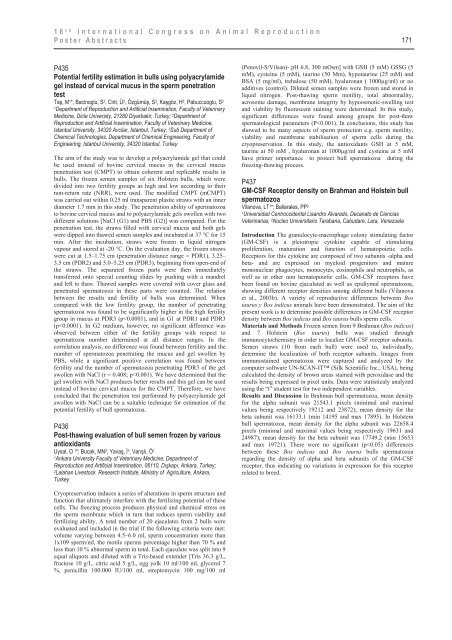Reproduction in Domestic Animals - Facultad de Ciencias Veterinarias
Reproduction in Domestic Animals - Facultad de Ciencias Veterinarias
Reproduction in Domestic Animals - Facultad de Ciencias Veterinarias
Create successful ePaper yourself
Turn your PDF publications into a flip-book with our unique Google optimized e-Paper software.
16 t h International Congress on Animal <strong>Reproduction</strong><br />
Poster Abstracts 171<br />
P435<br />
Potential fertility estimation <strong>in</strong> bulls us<strong>in</strong>g polyacrylami<strong>de</strong><br />
gel <strong>in</strong>stead of cervical mucus <strong>in</strong> the sperm penetration<br />
test<br />
Taş, M 1 *, Bac<strong>in</strong>oglu, S 2 , Cirit, Ü 2 , Özgümüş, S 3 , Kaşgöz, H 3 , Pabuccuoglu, S 2<br />
1Department of <strong>Reproduction</strong> and Artificial Insem<strong>in</strong>ation, Faculty of Veter<strong>in</strong>ary<br />
Medic<strong>in</strong>e, Dicle University, 21280 Diyarbakir, Turkey; 2 Department of<br />
<strong>Reproduction</strong> and Artificial Insem<strong>in</strong>ation, Faculty of Veter<strong>in</strong>ary Medic<strong>in</strong>e,<br />
Istanbul University, 34320 Avcilar, Istanbul, Turkey; 3 Sub Department of<br />
Chemical Technologies, Department of Chemical Eng<strong>in</strong>eer<strong>in</strong>g, Faculty of<br />
Eng<strong>in</strong>eer<strong>in</strong>g, Istanbul University, 34320 Istanbul, Turkey<br />
The aim of the study was to <strong>de</strong>velop a polyacrylami<strong>de</strong> gel that could<br />
be used <strong>in</strong>stead of bov<strong>in</strong>e cervical mucus <strong>in</strong> the cervical mucus<br />
penetration test (CMPT) to obta<strong>in</strong> coherent and replicable results <strong>in</strong><br />
bulls. The frozen semen samples of six Holste<strong>in</strong> bulls, which were<br />
divi<strong>de</strong>d <strong>in</strong>to two fertility groups as high and low accord<strong>in</strong>g to their<br />
non-return rate (NRR), were used. The modified CMPT (mCMPT)<br />
was carried out with<strong>in</strong> 0.25 ml transparent plastic straws with an <strong>in</strong>ner<br />
diameter 1.7 mm <strong>in</strong> this study. The penetration ability of spermatozoa<br />
to bov<strong>in</strong>e cervical mucus and to polyacrylami<strong>de</strong> gels swollen with two<br />
different solutions [NaCl (G1) and PBS (G2)] was compared. For the<br />
penetration test, the straws filled with cervical mucus and both gels<br />
were dipped <strong>in</strong>to thawed semen samples and <strong>in</strong>cubated at 37 °C for 15<br />
m<strong>in</strong>. After the <strong>in</strong>cubation, straws were frozen <strong>in</strong> liquid nitrogen<br />
vapour and stored at -20 °C. On the evaluation day, the frozen straws<br />
were cut at 1.5–1.75 cm (penetration distance range = PDR1), 3.25–<br />
3.5 cm (PDR2) and 5.0–5.25 cm (PDR3), beg<strong>in</strong>n<strong>in</strong>g from open-end of<br />
the straws. The separated frozen parts were then immediately<br />
transferred onto special count<strong>in</strong>g sli<strong>de</strong>s by push<strong>in</strong>g with a mandrel<br />
and left to thaw. Thawed samples were covered with cover glass and<br />
penetrated spermatozoa <strong>in</strong> these parts were counted. The relation<br />
between the results and fertility of bulls was <strong>de</strong>term<strong>in</strong>ed. When<br />
compared with the low fertility group, the number of penetrat<strong>in</strong>g<br />
spermatozoa was found to be significantly higher <strong>in</strong> the high fertility<br />
group <strong>in</strong> mucus at PDR3 (p

















